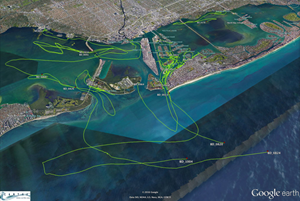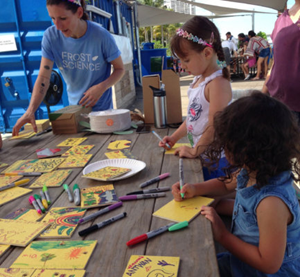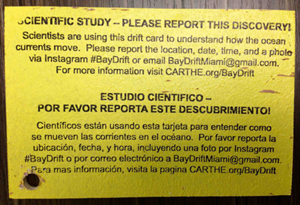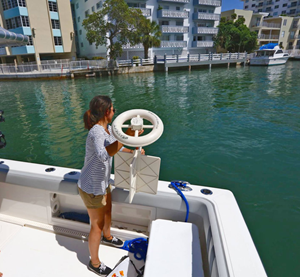
The CARTHE team is receiving data from 15 biodegradable, GPS-equipped drifters. This image shows the tracks after 24 hours. (Image by CARTHE)
It’s almost like a game of tug-of-war. There are growing numbers of residents, tourists, and industry at one end and the environment where people live, work, and play at the other. When the former increases, the latter is stressed. This scenario plays out all over the world, especially in coastal areas.
Biscayne Bay near Miami, Florida, is one of these areas. Its population, visitors, and businesses are booming, and its main harbor is expanding to accommodate large vessels in response to the widening of the Panama Canal. This growth has come with increased trash, wastewater runoff, and pollution that end up in the Bay, on beaches, and in mangrove forests. However, scientists are tugging on the same side of the rope as local citizens, pulling resources together to address this environmental concern.

Families worked with Vizcaya Museum and Gardens, Miami Science Barge, and Patricia and Phillip Frost Museum of Science to beautifully paint cards for the Bay Drift study. (Photo by Laura Bracken)
Recently, members of the Vizcaya Museum and Gardens noticed that a lot of debris was accumulating at their waterfront, and they wanted to know why. Vizcaya contacted the Patricia and Phillip Frost Museum of Science who in turn contacted the Consortium for Advanced Research on Transport of Hydrocarbon in the Environment II (CARTHE II) based at the University of Miami. Other local groups joined the conversation: The International SeaKeepers Society, Insetta Boatworks, Miami Waterkeeper, Miami Science Barge, Surfrider Foundation Miami Chapter, and Biscayne Bay Aquatic Preserves. Conversations turned into action which resulted in the Bay Drift Study.

Each yellow card is coded and has information that introduces the project and instructs the finder how to report its location. Tracking the location where drift cards are released and found helps researchers to learn how the currents distribute debris in Biscayne Bay (Photo by Laura Bracken)
“This project is an enormous collaborative effort,” said CARTHE Outreach Lead Laura Bracken. “The groups we have partnered with and the many people who have heard about the project want to get involved because they feel so passionately about the issue.”
CARTHE, funded by the Gulf of Mexico Research Initiative, has developed the scientific expertise that is perfect for learning about how particles move in water. They have been conducting research since 2012 to improve our understanding about how ocean currents affected the movement of Deepwater Horizon oil.
“Large oil spills like the Deepwater Horizon event don’t happen very often, but there are continuous pollution events that occur near coastal cities that can take an economic toll,” said Rosenstiel School of Marine and Atmospheric Science oceanographer and CARTHE Director Tamay Özgökmen. “We can use the same technologies we developed to study the oil spill and apply them to address this problem.”

Graduate student Simge Bilgen, a CARTHE team member, deploys a drifter at a water discharge location in the Miami Beach area. The drifters measure currents at the water’s surface, where wind and waves can whip around much faster than deeper currents. The drifters’ GPS trackers lets the team calculate the speed and path of currents. (Photo by Tamay Ozgokmen)
The project uses technology and techniques developed for the CARTHE LASER experiment, such as bamboo drift plates and custom-made GPS-equipped biodegradable drifters, to study how trash, sewage, oil, and harmful algae blooms are transported through South Florida waters. From September 2016 to June 2017, the team will coordinate quarterly drift card deployments from eight locations with scientists, students, families, and members of the community across northern Biscayne Bay.
The project team has several goals: use science to advance understanding of the area’s flow patterns, provide students with a hands-on STEAM (STEM + Art) activity, develop a computer model to visualize how debris moves, and make information publicly available to help sustain local shorelines.

Maritime and Science Technology (MAST) Academy students prepare to release drift cards and plates that they painted into Bear Cut. (depends on where you got this photo. (Photo by Diana Udel)
Özgökmen explains what they have learned so far, “The flow trajectories indicate a lot of stop-and-go near the shores due to coastal structures such as marinas, followed by episodic flushing of material into the Florida Current. Understanding how long pollution stays in the Bay is very important, and we can quantify this by using our drifters.”
It’s knowledge like this that could inform future decisions. “If we don’t tackle this from the root, it’s not a real solution,” said Vizcaya Museum & Garden schools program manager Diana Pena. “We’re hoping this information gives us enough to reach out to the public and realize how important they are to environmental stewardship.”
Özgökmen expressed that he and the CARTHE team are excited that the tools and experience that they developed with GoMRI support are addressing a serious coastal pollution problem that is important to local community.
Bay Drift drifter tracks Sept 12-20 from CARTHE on Vimeo.
************
The Gulf of Mexico Research Initiative (GoMRI) is an independent research program established to study the effect, and the potential associated impact, of hydrocarbon releases on the environment and public health, as well as to develop improved spill mitigation, oil detection, characterization and remediation technologies. An independent and academic 20-member Research Board makes the funding and research direction decisions to ensure the intellectual quality, effectiveness and academic independence of the GoMRI research. All research data, findings and publications will be made publicly available. The program was established through a $500 million financial commitment from BP.
